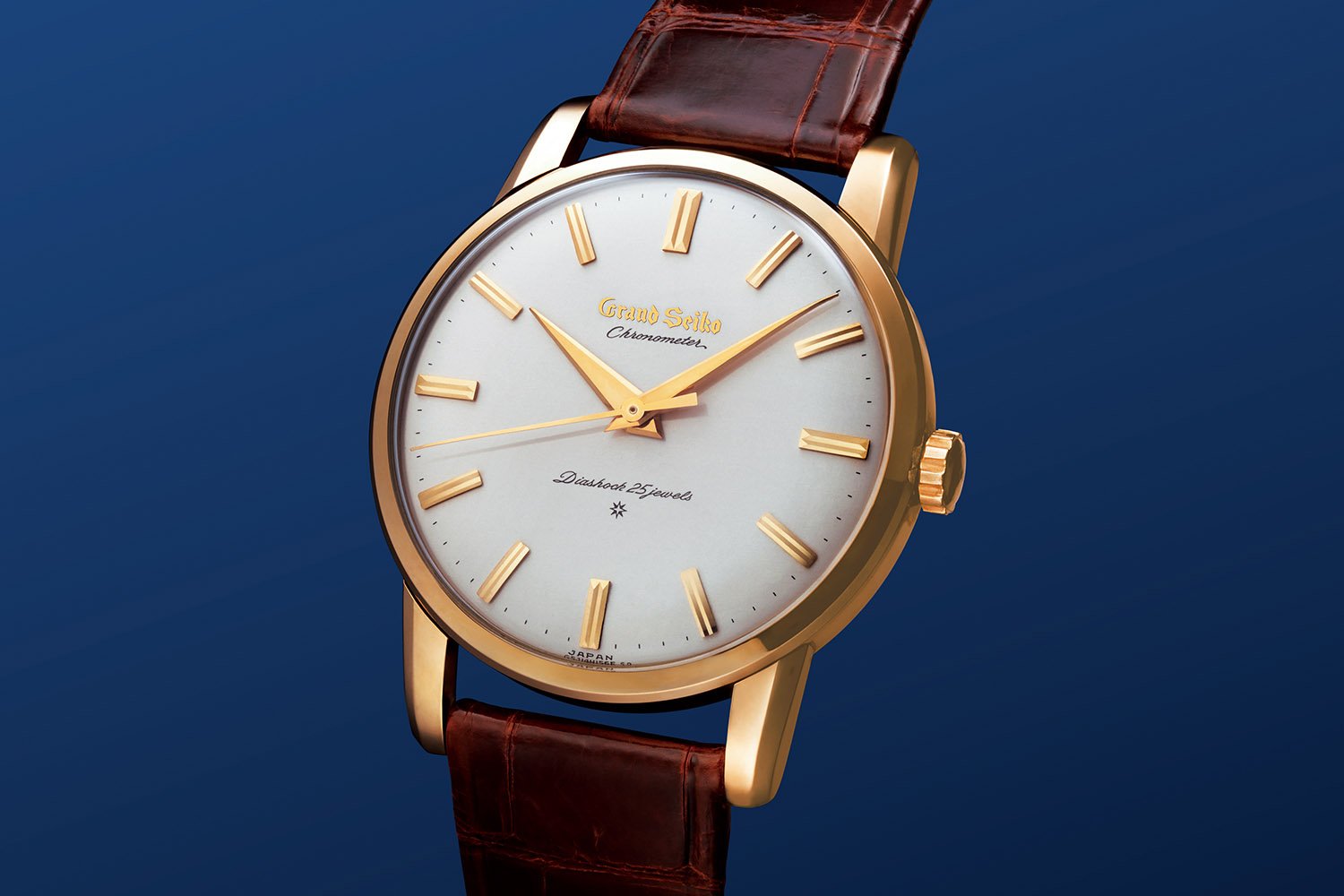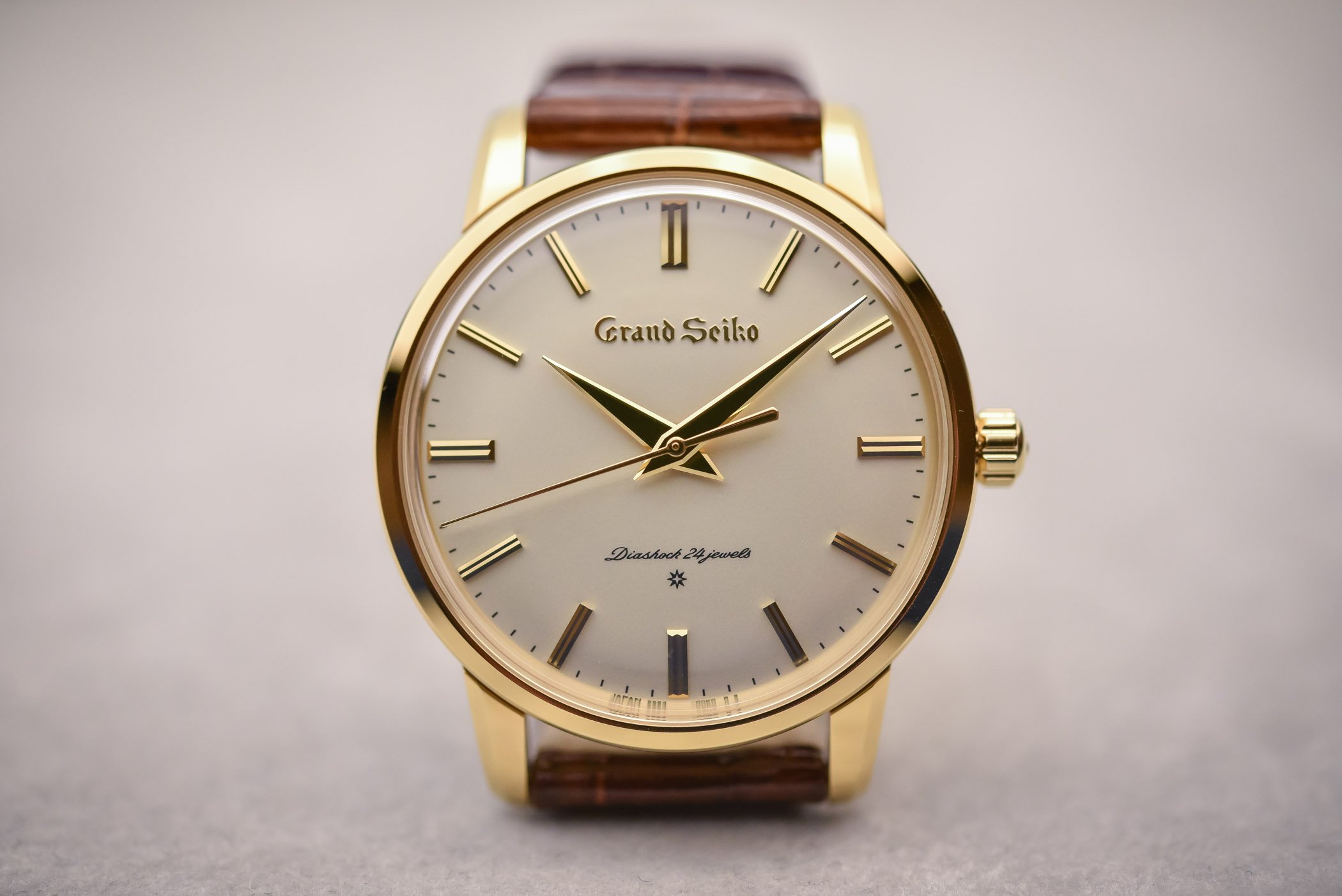The New Grand Seiko Elegance 1960, Re-Creations of the First Grand Seiko
Celebrating the 60th anniversary of the high-end Japanese watchmaker by "relaunching" the first-ever model.

For many international watch enthusiasts, the name Grand Seiko refers to modern and innovative luxury watches – Spring Drive technology is largely responsible for this impression. The brand really started to communicate and sell outside of its home market only a decade ago, hence the association with “modern watchmaking”. However, there’s so much more to learn about this brand that was created back in 1960 and has been producing some of the finest watches the Japanese archipelago has ever seen. This year, the brand celebrates its 60th anniversary and what could have been a better tribute than revisiting the first-ever watch to bear the name Grand Seiko? Let’s take a closer look at the new Grand Seiko Elegance 1960 Re-Creations.
THE FIRST-EVER GRAND SEIKO
Although the international launch of Grand Seiko took place in 2010, the name actually dates back to 1960. That year, the already well-established Japanese brand Seiko decided to consolidate the best of its production in a single watch, hence the name “grand” added in front of Seiko. A team in Seiko’s Suwa facility in central Japan had been working on the creation of a watch that would be the epitome of precision, durability, comfort and beauty.

The result, launched on 18 December 1960, is the watch you can see above; a classic piece in a 35mm, yellow gold (14k) case with a slim chronometer-rated movement whose precision met the highest international standard of the time. This watch also established the foundation of the brand’s design codes, which includes the sharp faceted hands, the double hour markers and the famous polishing technique that makes the Grand Seiko cases so attractive.

This watch was celebrated at Baselworld 2017 with three limited-edition reissues, the SBGW251, SBGW252 & SBGW253 – which have been explored in detail here. Since these watches were sold out and the brand is celebrating its 60th anniversary in 2020, it was the perfect moment to see this beautiful and elegant design as a permanent member of the collection and not limited in production.
A closer look at the 2020 Grand Seiko 1960 Re-Creations
As such, these three watches, references SBGW257, SBGW258 and SBGW259, aren’t entirely new to Grand Seiko fans, as they use the same recipe that was used in 2017.
Case, dial layout and movement are the same too but some details in the materials and colours have changed to create a trilogy that stands out from the previous limited editions. So let’s take a closer look, as we were one of the first to have the opportunity to see these watches in the metal – just like we did with another 2020 introduction, the Seiko Prospex 62MAS Re-Creation.

In today’s article, we’ll only introduce you to the platinum (SBGW257) and the titanium version (SBGW259), as the yellow gold model (SBGW258) wasn’t available yet. However, it is almost identical to the reference SBGW252 introduced in 2017, except that it now features a sapphire caseback and a three-fold clasp
ELegant Case and restrained proportions
The basic idea with this new trilogy of watches was to pay a faithful tribute to the watch that actually launched Grand Seiko back in 1960, yet with a slightly modernized package. You won’t be surprised then to see that most of the design elements of the 1960 “Diashock” watch have been reutilized, starting with the case.
What’s surprising when you look at the first-ever Grand Seiko is how most of GS design codes were already there… The hands, the polished surfaces, the shapes, the indexes, this first austere look that is very lively in reality… This watch was the foundation of the whole GS success and the brand has kept it alive since then, with no drastic alteration of its design.
The case is shaped almost identically shaped in the 2020 trilogy of 1960 Re-Creations. The thin smooth bezel, the elongated, slightly bulky lugs with rounded profile and bevel and the sleek profile all make the filiation undeniable. The main evolution doesn’t concern the shape but the size. Instead of a slightly outdated and very-1960s diameter of 35mm, Grand Seiko has opted for a diameter of 38mm. In all fairness, this remains very compact and sets the tone for these watches, which have to be considered proper dress timepieces – a sort of Calatrava, the Japanese way. As often with Grand Seiko, the case could have been thinner but at just under 11mm in height, the thickness remains acceptable.
This elegant case is, as said, available in three variants, from high-end platinum to classic yellow gold or surprisingly modern and light titanium. Although the two precious metal versions were somehow anticipated, the choice for the “entry-level” model is more unanticipated. While we’re used to seeing stainless steel, Grand Seiko opts here for its “Brilliant Hard Titanium”, an equivalent to grade 5 that allows for polished surfaces.
The case is finished in the typical Grand Seiko way, meaning superb distortion-free surfaces obtained via the Zaratsu (blade polishing) technique. The watches, whether platinum or titanium, have a handsome lustre and shine. All models are worn on classic and elegant rolled-edge crocodile strap (black on platinum, brown on gold and blue on titanium), closed by a triple-folding clasp in matching material.
On the wrist, these watches are compact, elegant yet with some character. They might be simple 3-handers, the reflections from the case (and the dial/hands, more on that later) offer an outstanding presence. On an 18cm wrist like here, there can be no doubt about their elegant vocation. Depending on the metal chosen, the sensation is slightly different, the platinum model offers a “weight of quality” feel while the lightweight titanium version goes unnoticed after a few minutes.
Typical GS dial and hands
The dials of these 1960 Re-Creations are unmistakably Grand Seiko. You’ll recognize the brand immediately, even without a logo printed on the dial. Once again everything feels like the original 1960 model, down to the return of the “Diashock xx jewels” mention at 6 o’clock, except that the movement is different, and now “24 jewels” is printed instead of “25 jewels”.
Hands and indexes are executed in the traditional, hyper-detailed Grand Seiko way. This means perfectly finished mirror-polished surfaces, changing from bright metallic to almost black reflections depending on the angle of the ambient light. The hands feature ultra-sharp polished bevels and the indexes are identical to the 1960 model – double-faceted batons, slightly wider at 12, 3, 6 and 9 o’clock.
Each metal has its own dial here. The platinum version is equipped with an equally precious dial, made of solid 18k white gold, with a sunray-brushed finish and the Grand Seiko logo engraved into the material. It is paired with silver-coloured hands. The 18k yellow gold model has a warm silver dial with a matte opaline surface and all the elements are made from 18k yellow gold too (hands, indexes and applied logo). Finally, the titanium version opts for a more casual look with a brushed top surface of the hands and a sunray deep blue dial with a printed logo.
Legibility and contrast are great on both models we had for this review and the execution, whether on the high-end platinum SBGW257 or the more accessible titanium SBGW259 are as expected from Grand Seiko… Stunningly precise.
a well-known hand-wound Movement
To power this trilogy of 1960 Re-Creation, Grand Seiko didn’t look too far and picked a well-known movement, the hand-wound calibre 9S64, manufactured in-house.
This movement is a tried-and-tested base that has a great track record. It was already used in the 2017 limited edition trilogy and powers one of our favourite Grand Seiko watches, the compact and elegant SBGW231 that we reviewed here. In short, we’re in family territory with a movement introduced into the Grand Seiko line in 2011.
This 9S64 is one of the few hand-wound mechanical movements in the GS collection – even though the brand has now introduced more hand-wound mechanical (with this same movement) and Spring-Drive watches. As such, it honours its 1960 predecessor equipped with calibre 3180, a manual-winding, 25-jewel, chronometer-grade movement.
The Calibre 9S64 is a pretty straightforward engine that is capable of storing 72 hours of power reserve from a single mainspring and that beats at a classical frequency of 4Hz. However, it is a very precise movement too, with an accuracy of +5 to –3 seconds per day and an adjustment in 6 positions. The look is simple, with a large main bridge, yet with nice decoration. The sapphire caseback has a discreet Grand Seiko Lion transferred on its surface.
Thoughts, Availability & Price
While not a total surprise, as they are quite close to the 2017 trilogy, Grand Seiko made the right decision to bring back this design as a permanent member of the collection, in order to offer a genuine dress watch with vintage touches. The three models are elegant, greatly proportioned and perfectly executed, with a slight preference for the lightweight and more casual take offered by this surprising titanium version – a material often seen on sports watches, rarely on such an elegant piece.
The three Grand Seiko Elegance 1960 Re-Creation watches will be available as of June 2020 worldwide, as permanent members of the collection. The platinum SBGW257 will be priced at EUR 39,000, the 18k yellow gold SBGW258 at EUR 27,000 and the titanium SBGW259 at EUR 8,300. More details at grand-seiko.com.




















2 responses
Yeah, the price for precious metal Grand Seikos should be a well-known industry joke by now. Bloody hell.
The stop click mechanism (hope I got the name correct) is the most interesting part of the watch. It appears almost like a blade mounted on a jewel. Like a guillotine. The whole ebauche just a finely finished hand wound movement that could have been produced in the 1700 hundreds.